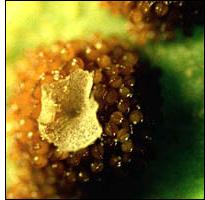Species Studied
- Arbutus menziessi (Pacific Madrone)
- Arctostaphylos columbiana (Hairy Manzanita)
- Arctostaphylos x media (Hybrid Manzanita)
- Rhododendron macrophyllum (Pacific Rhododendron)
- Vaccinium ovalifolium (Oval-leafed blueberry)
- Vaccinium parvifolium (Red Huckleberry)
- Mahonia nervosa (Dull leafed Oregon grape)
- Mahonia aquifolium (Tall Oregon grape)
- Ribes aureum (Golden currant)
- Polystichum munitum (Western Sword fern)
- Adiatum pedatum (Maidenhair fern)
Collection Areas
- Rhododendron Lake, Parksville
- Copper Canyon, Chemanius
- Westwood Lake, Nanaimo
- Milner Gardens, Qualicum
- Native Plant Garden, Royal British Columbia Museum, Victoria
Types of Cuttings
- Basal cutting - area of a cutting that is situated closest to the previous years' wood, or the base of a long juvenile stem.
- Tip cutting - current years' wood from the very top of the branch or plant.
- Wounding - a one centimeter long slice of outer bark taken off the side of the cutting at the base, exposing the cambium layer. This allows more area for rooting.
Rooting Hormone
- Stimroot #3 - Indole-3 butyric acid 0.8%
Successful Vegetative Propagation Results By Species
| Arctostaphylos columbiana | ||
|---|---|---|
| Type of Cutting: | basal with wounding at the base of the cutting | |
| Cutting Media: | 1:1 perlite/peat moss | |
| Rooting Hormone: | Stimroot #3 IBA | |
| Environmental Factors: | bottom heat (70 degrees F.) | |
| Best Time of Year: | March, September, October, November | |
| Arctostaphylos x media | ||
|---|---|---|
| Type of Cutting: | basal with wounding at the base of the cutting | |
| Cutting Media: | 2:1 peat moss/perlite | |
| Rooting Hormone: | Stimroot #2 IBA | |
| Environmental Factors: | bottom heat (70 degrees F.), mist every hour for five-second intervals for the first two weeks during hot weather | |
| Best Time of Year: | September, October, November | |
| Vaccinium ovalifolium | ||
|---|---|---|
| Type of Cutting: | basal using juvenile wood | |
| Cutting Media: | 2:1 peat moss/perlite | |
| Rooting Hormone: | Stimroot #3 IBA | |
| Environmental Factors: | bottom heat ( 70 degrees F.) | |
| Best Time of Year: | September - April | |
| Vaccinium parvifolium | ||
|---|---|---|
| Same as Vaccinium ovalifolium | ||
| Mahonia nervosa | ||
|---|---|---|
| Type of Cutting: | top five to six centimeters of main stem or side branch, leaving only one or two leaflets on, wounding base of cutting | |
| Cutting Media: | 2:1 peat moss/perlite | |
| Rooting Hormone: | Stimroot #3 IBA | |
| Environmental Factors: | bottom heat (70 degrees F.) | |
| Best Time of Year: | September - March | |
Species with rooting percentages less than fifty percent were omitted from this abstract.
Fern Spore Propagation

Seed Propagation
Rhododendron macrophyllum - seeds collected late September, stratified in cooler (2 degrees Celsius), sown in February on top of 2:1 peat moss/perlite media. Germinated in two weeks.
Vaccinium ovalifolium, Vaccinium parvifolium - berries collected as they matured, soaked in warm water for twenty-four hours, cleaned and sown onto the top of 2:1 peat moss/perlite media. Germination occurred within one month. No stratification was required
Mahonia nervosa - berries were collected when mature, leached in warm water for twenty-four hours, cleaned and stratified for thirty, sixty and ninety day cold periods. The sixty and ninety day trials germinated between sixty to eighty percent, in a 2:1 peat moss/perlite media, covered and put onto a heated propagation bed. (70 degrees Fahrenheit)
For the cost of the printing, a copy of the full report is available by contacting the Horticulture Department of Vancouver Island University. A second year report will also be available in September 1999.
Additional native plant propagation species being studied in the second year are: Lilium columbianum (Tiger lily), Fritillaria lanceolata (Chocolate lily), Trillium ovatum (Western Trillium), Oemleria cerasiformis (Indian Plum), Achyls triphylla (Vanilla leaf plant).
Vancouver Island University and Green Thumb Nursery, Nanaimo, BC.
Funded By Science Council of British Columbia
